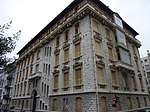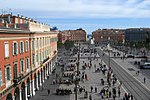Siege of Nice
1543 in France1543 in the Holy Roman Empire1543 in the Ottoman EmpireCharles V, Holy Roman EmperorConflicts in 1543 ... and 11 more
History of NiceIslam in FranceItalian War of 1542–1546Sieges involving FranceSieges involving SavoySieges involving SpainSieges involving the Holy Roman EmpireSieges involving the Ottoman EmpireSieges involving the Republic of GenoaSieges of the Italian WarsSuleiman the Magnificent

The siege of Nice occurred in 1543 and was part of the Italian War of 1542–46 in which Francis I and Suleiman the Magnificent collaborated as part of the Franco-Ottoman alliance against the Holy Roman Emperor Charles V, and Henry VIII of England. At that time, Nice was under the control of Charles III, Duke of Savoy, an ally of Charles V. This is part of the 1543–1544 Mediterranean campaign of Barbarossa.
Excerpt from the Wikipedia article Siege of Nice (License: CC BY-SA 3.0, Authors, Images).Siege of Nice
Boulevard Victor Hugo, Nice Quartier Jean-Médecin
Geographical coordinates (GPS) Address Nearby Places Show on map
Geographical coordinates (GPS)
| Latitude | Longitude |
|---|---|
| N 43.7 ° | E 7.26667 ° |
Address
Jean Médecin
Boulevard Victor Hugo
06000 Nice, Quartier Jean-Médecin
Provence-Alpes-Côte d'Azur, France
Open on Google Maps











